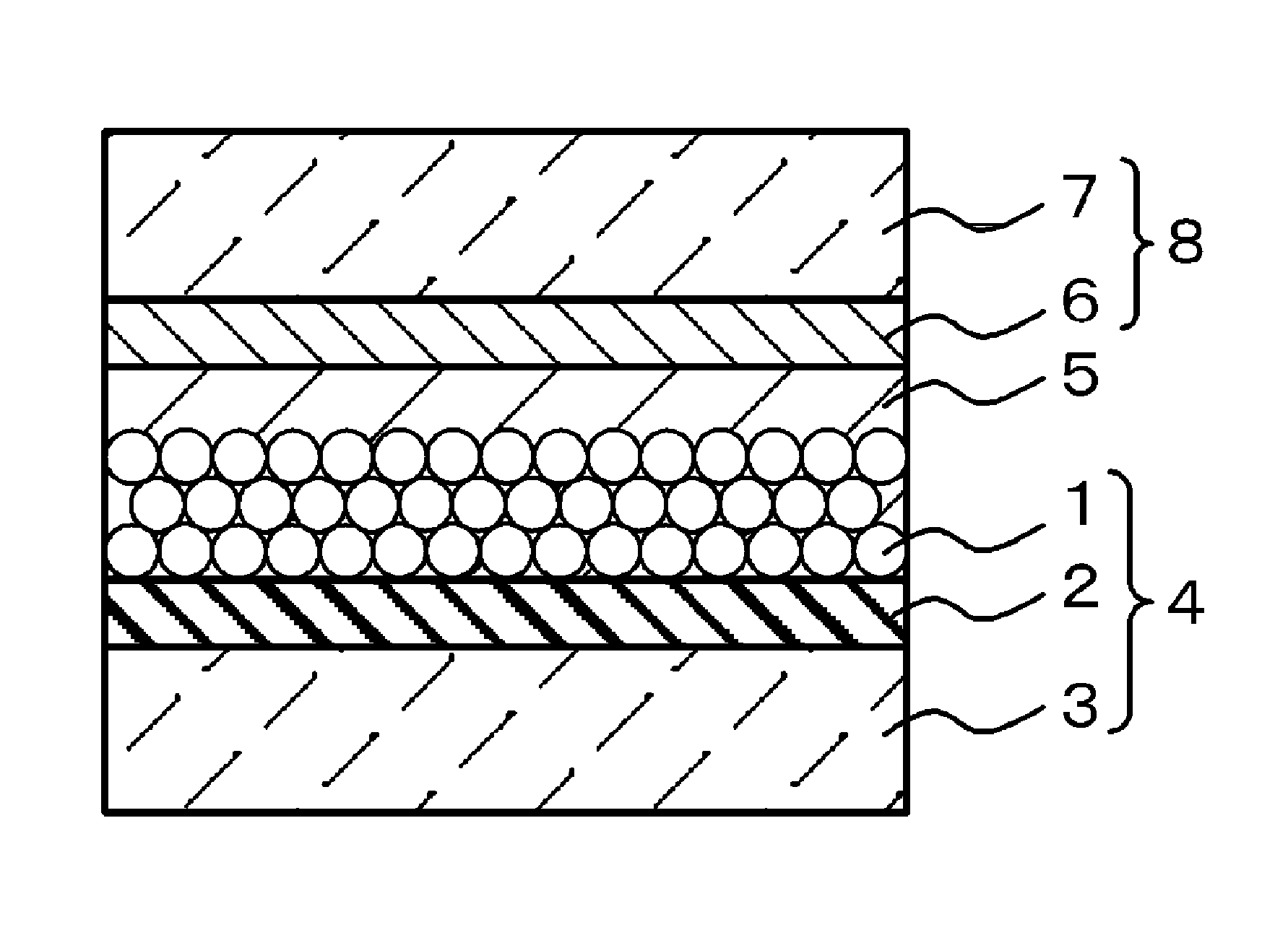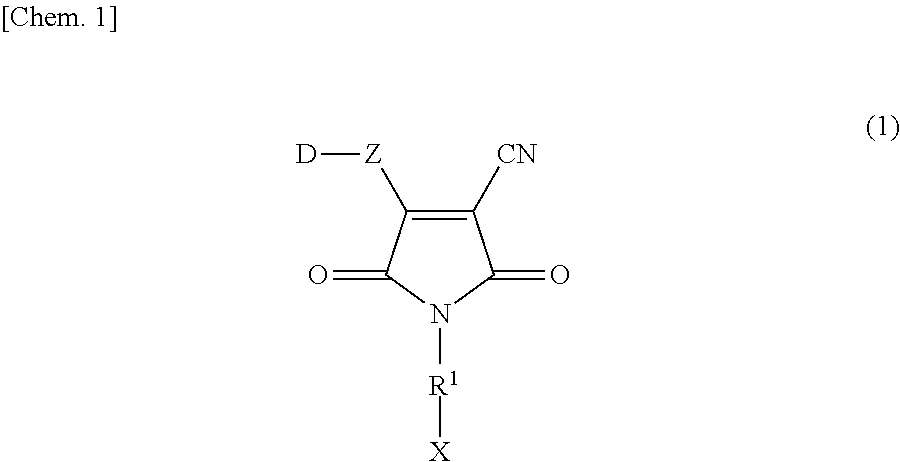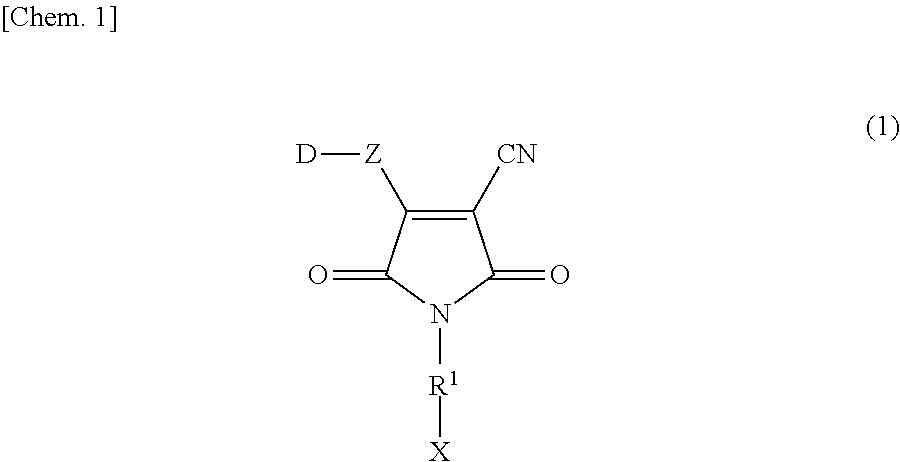Maleimide-based compound, and tautomer or stereoisomer thereof, dye for photoelectric conversion, and semiconductor electrode, photoelectric conversion element and photoelectrochemical cell using the same
a technology of tautomer or stereoisomer, compound and compound, which is applied in the direction of triarylamine dye, electrolytic capacitor, organic chemistry, etc., can solve the problems of difficult to achieve a higher photoelectric conversion efficiency in comparison to ruthenium complexes, interfering with the distribution of cells, and high cost of solar cells, etc., to achieve excellent photoelectric conversion characteristics
- Summary
- Abstract
- Description
- Claims
- Application Information
AI Technical Summary
Benefits of technology
Problems solved by technology
Method used
Image
Examples
example 1
Synthesis of Maleimide-Based Compound M1
[0102]
[0103]2 g of 2-chloro-3-cyanomaleimide (synthesized by the method described in J. Am. Chem. Soc., 80, p. 1385-1388 (1958)) was dissolved in 100 ml of acetonitrile, and 4.19 g of 4-(thiophen-2-yl)triphenylamine was added thereto, followed by allowing them to undergo a reaction at room temperature overnight. The reaction mixture was washed with 600 ml of water, and the precipitated crystal was separated by filtration and washed several times with warm water. In addition, the resultant was washed with 100 ml of ethanol under heating and stirring to obtain 3.15 g (yield 55%) of a compound B1.
[0104]Next, 2 g of the compound B1 and 1.31 g of t-butyl bromoacetate were dissolved in 80 ml of acetonitrile, and 0.62 g of potassium carbonate was added thereto, followed by stirring at 80° C. for 2 hours. Further, after leaving to cool, 1000 ml of ice water was poured thereinto and the precipitated crystal was separated by filtration. In addition, the...
example 2
Synthesis of Maleimide-Based Compound M2
[0107]
[0108]A solution of 7.16 g of p-bromoaniline, 32 g of p-hexyloxyiodobenzene, and 1.51 g of 1,10-phenanthroline in toluene (84 ml) was heated to 100° C., and 20.75 g of potassium hydroxide and 0.831 g of copper (I) chloride were added thereto, followed by stirring for 24 hours. After leaving to cool, the resultant was separated by filtration and washed with toluene, and the solvent was evaporated under reduced pressure. The residue was separated and purified by silica gel columns (eluent: hexane / chloroform=5 / 1) to obtain 10.9 g of a compound C1.
[0109]Next, 3.6 g of tetrakis(triphenylphosphinepalladium) was added to a solution of 163.6 g of the compound C1 and 173 g of 2-tributyltin-3,4-ethylenedioxythiophene in 2400 ml of anhydrous toluene, followed by heating and refluxing for 40 hours. The solvent was evaporated under reduced pressure, and separated and purified by silica gel columns (eluent: hexane / toluene=1 / 1) to obtain 75.19 g of a c...
example 3
Synthesis of Maleimide-Based Compound M3
[0114]
[0115]4.8 g of the compound C2 was dissolved in 60 ml of N,N-dimethylformamide (DMF), and a solution having 1.6 g of N-bromosuccinimide dissolved in 10 ml of DMF was added dropwise thereto under ice-cooling. Thereafter, after stirring for 4 hours, water was added to the reaction mixture, and the organic layer was extracted with ethyl acetate. After drying over magnesium sulfate, the solvent was evaporated under reduced pressure, and the residue was separated and purified by silica gel columns (eluent: hexane / ethyl acetate=5 / 1) to obtain 3.929 g of a compound D1.
[0116]Next, 0.11 g of tetrakis(triphenylphosphinepalladium) was added to a solution of 2 g of the compound D1 and 2.235 g of 5-tributyltin-2,2′-bis(3,4-ethylenedioxythiophene) in 30 ml of anhydrous toluene, followed by heating and refluxing for 12 hours. The solvent was evaporated under reduced pressure, and the residue was washed with 80 ml of hot methanol three times to obtain 1...
PUM
| Property | Measurement | Unit |
|---|---|---|
| thickness | aaaaa | aaaaa |
| specific surface area | aaaaa | aaaaa |
| porosity | aaaaa | aaaaa |
Abstract
Description
Claims
Application Information
 Login to View More
Login to View More - R&D
- Intellectual Property
- Life Sciences
- Materials
- Tech Scout
- Unparalleled Data Quality
- Higher Quality Content
- 60% Fewer Hallucinations
Browse by: Latest US Patents, China's latest patents, Technical Efficacy Thesaurus, Application Domain, Technology Topic, Popular Technical Reports.
© 2025 PatSnap. All rights reserved.Legal|Privacy policy|Modern Slavery Act Transparency Statement|Sitemap|About US| Contact US: help@patsnap.com



